Chemistry and Chemists № 1 2024
Journal of Chemists-Enthusiasts
| Content | Chemistry experiments - video | Physics experiments - video | Home Page - Chemistry and Chemists |
|
Chemistry and Chemists № 1 2024 Journal of Chemists-Enthusiasts |
Flowers change colour: effect of alkalis and acids on plant dyes - pt.23, 24 V.M. Viter |
|
Having noticed a mistake in the text, allocate it and press Ctrl-Enter
Red leaves of Parthenocissus quinquefolia and ammonia - pt.23
The leaves of most plants are green because they contain a pigment called chlorophyll. Chlorophyll is very important for life on Earth since plants capture the energy of the Sun's light, converting it into the energy of chemical bonds. Simultaneously, plants transform the composition of our atmosphere; in turn, the atmosphere determines the climate. Don't believe me? You can fly to Venus for a fun weekend. Venus is not the closest planet to the Sun, but it is the most... how can I say... "warm" (metallic lead will melt on the surface). This extreme climate is due to Venus having a dense atmosphere of carbon dioxide.Despite the enormous importance of chlorophyll for life on Earth, it does not look interesting for our experiments. In addition to green, leaves can be coloured in other colours, for example, red, because such leaves contain anthocyanins. Anthocyanins are the pigments with which we are now experimenting. They are found in flowers, berries and other parts of plants, including leaves. Does this mean leaves can change colour when treated with acids and bases (similar to flowers and fruits)? I did such an experiment many years ago with a red amaranth leaf [1]. As a result of ammonia treatment, the red leaf turned green. Usually, amaranth has green leaves initially, but all this plant was red and burgundy. Apparently, it was an ornamental variety of amaranth. Often, colourful (not green) leaves are found in ornamental plants. But there is another possibility: in the autumn, green leaves turn yellow, red and burgundy. The leaves of yellow and orange colour are not very interesting to us. These colours are due to the presence of carotenoids (xanthophylls). I already tried to experiment with yellow and orange flowers of tagetes (in this article); the result was not impressive [2]. There would be nothing to write about if there were no pigments other than carotenoids in these flowers! But red and burgundy colours look promising: these colours are due to the presence of anthocyanins in the leaves. A red apple turned almost black in ammonia; red Finnish whitebeam fruits turned brown; red flowers often turned blue, purple, green or yellow. And what changes will occur to the red and burgundy autumn leaves? Based on the single experiment with an amaranth leaf mentioned above, it can be assumed that the red leaves will turn green (it will be "reverse autumn"). By the way, it is autumn now. The leaves on the plants turned yellow, red and burgundy. I need to hurry with experiments before the leaves fall. Which plant should I choose for the experiments? On most plants, green leaves turn yellow, but there are significantly fewer plants whose leaves turn red. First, a climbing ornamental plant that looked like a grape came to mind. We call it "wild grapes". Its peculiarity is that the green leaves of the "wild grapes" turn dark red in the autumn. This does not always happen (sometimes the leaves of this plant turn yellow), but in most cases, the leaves turn red. After the experiments, I began to search for the exact biological name of the species. It turned out that the Latin name is Parthenocissus quinquefolia. There are several English names at once - Virginia creeper, Victoria creeper, five-leaved ivy, or five-finger. The Ukrainian name of the species is "Дикий виноград п'ятилистий" (literally, it means "Five-leaved wild grape"). That is, the Ukrainian botanical name of this species almost coincides with the "unofficial" name of the plant in our area. Further in the text, I will call the plant "Virginia creeper". Virginia creeper is native to North America but is grown worldwide as an ornamental. In Ukraine, Virginia creeper has become widespread; it is used for landscaping parks and gardens. Moreover, in our country, this plant often "grows itself" (without human assistance or permission). Introduced species often migrate from gardens and parks into the wild. Sometimes, they cause huge harm to native ecosystems. __________________________________________________ 1 See the article Plants as acid-base indicators / Растения в качестве кислотно-основных индикаторов [link]. 2 Tagetes flower and ammonia - p.12 [link].
A climbing vine that grows quite quickly. It can reach a height of up to 30 m. I have repeatedly seen Virginia creeper entwining the trunks and crowns of the tallest pines, steep hills slopes, and buildings' high walls. The stems and leaves are green in spring and summer, but the young shoots and leaves are red. By the way, I noticed a similar phenomenon in other plants when young shoots and leaves are not green but have a red or burgundy colour. In other words, anthocyanins are found in the leaves and shoots of plants in spring/summer (not only in autumn), but chlorophyll masks their presence. As a child, I experimented with such coloured leaves and shoots (acting on them with acids and bases), but I do not remember the results - many years have passed. Virginia creeper fruits are dark blue berries. It is similar to grapes, only much smaller. I read that they are toxic to humans due to the high oxalic acid content (deaths are possible if consumed). But they are edible for birds. Yesterday, I tried a ripe Virginia creeper berry. I did not feel the sour taste at all. Oxalic acid has a strong sour taste (like most other organic acids). I told my colleague. He replied: - Perhaps oxalic acid is contained in berries in the form of salts. - Wikipedia says that they contain oxalic acid, not oxalates. - What do you want from biologists? - Moreover, this is Wikipedia. The russian version of Wikipedia contains many errors, much unreliable information (and deliberate distortions of facts). There are fewer errors in the English version, but they are still there. In any case, I have not died from eating one berry yet, so let us continue.
I placed a large red leaf of Virginia creeper in a 5-litre jar and added a concentrated ammonia solution. Now, we have to wait. The dark red surface of the leaf gradually became dark green (primarily in those places where the solution got in). The colour change took a few minutes. Thus, during the treatment of the leaf with ammonia, we observed "autumn in reverse mode": the red leaf turned green. It turns out that this was not the end of the matter. The colour changes continued, and the dark green leaf turned brown (chocolate colour). The magic is cancelled... |
|
Красные листья Parthenocissus quinquefolia и аммиак - ч.23
Листья большинства растений окрашены в зеленый цвет - за счет того, что в них содержится хлорофилл. Хлорофилл имеет исключительное значение для жизни на Земле, поскольку растения не только улавливают энергию солнечного света, переводя ее в энергию химических связей. Растения также преобразуют состав нашей атмосферы, а атмосфера определяет климат. Не верите? Слетайте на выходные на Венеру. Венера - не самая близкая к Солнцу планета, но самая..., как бы это сказать... "теплая" (на поверхности будет плавиться свинец). Такой экстремальный климат - результат того, что Венера имеет плотную атмосферу из углекислого газа. Несмотря на исключительную важность хлорофилла для жизни на Земле, для наших экспериментов он не выглядит интересным. Листья растений могут быть окрашены не только в зеленый, но и в другие цвета, например, в красный, за счет того, что листья содержат антоцианы. Антоцианы - пигменты, с которыми мы сейчас экспериментируем. Они содержатся в цветах, ягодах и других частях растений, включая листья. Значит ли это, что листья тоже могут менять цвет при действии кислот и оснований (аналогично цветам и плодам)? В прошлом я уже провел такой эксперимент с красным листом амаранта [1]. Под действием аммиака красный лист стал зеленым. Обычно амарант имеет зеленые листья изначально, но данное растение было полностью красным (и бордовым, по-видимому, это был декоративный сорт амаранта. Разноцветные (не зеленые) листья часто имеют именно декоративные растения. Правда, есть и еще одна возможность: осенью зеленые листья становятся желтыми, красными и бордовыми. Желтый (и оранжевый) цвет листьев не очень нам интересен - он обусловлен присутствием каротиноидов (ксантофиллов). Я уже пробовал поэкспериментировать с желтыми и оранжевыми цветами tagetes / чорнобривців (в этой статье) - результат не впечатлил [2]. Если бы в этих цветах не оказалось других пигментов, кроме каротиноидов, то и писать было бы не о чем! Зато красный и бордовый выглядит перспективно: данные цвета обусловлены присутствием в листьях антоцианов. Красное яблоко стало в аммиаке почти черным, красные плоды рябины - коричневыми, красные цветы часто становились голубыми, фиолетовыми, зелеными, желтыми. А какие изменения произойдут с красными и бордовыми осенними листьями? Исходя из упомянутого выше единственного эксперимента (с листом амаранта) можно предположить, что красные листья станут зелеными (будет "осень наоборот"). Кстати, сейчас как раз осень. Листья на растениях стали желтыми, красными и бордовыми. С экспериментами нужно поспешить, пока листья не опали. Какое именно растение выбрать? На большинстве растений зеленые листья становятся желтыми, а растений, листья которых краснеют, значительно меньше. Прежде всего, в голову пришло вьющееся декоративное растение, похожее на виноград. У нас его называют "дикий виноград". Его особенность в том, что зеленые листья "дикого винограда" становятся осенью темно-красными. Это происходит не всегда (иногда листья данного растения желтеют), но в большинстве случаев листья краснеют. Уже после экспериментов стал искать точное биологическое название вида. Оказалось, что латинское название Parthenocissus quinquefolia. Английских названий сразу несколько - Virginia creeper, Victoria creeper, five-leaved ivy, or five-finger. Украинское название вида - Дикий виноград п'ятилистий. Русское - Девичий виноград пятилисточковый. Т.е., украинское ботаническое название данного вида действительно почти совпадает с "неофициальным" названием растения в нашей местности. Далее для краткости буду дальше называть это растение "дикий виноград". Родиной данного растения является Северная Америка, но по всему миру его выращивают как декоративное. В частности, дикий виноград получил распространение в Украине - его используют для озеленения парков, садов. Более того, у нас данное растение часто "само себя выращивает". Это типичная ситуация: завезенный вид перекочевывает из садов, огородов и парков в дикую природу. Иногда они наносят огромный вред местным экосистемам. Дикий виноград растет довольно быстро и может достигать до 30 м в высоту. Я не раз видел, как дикий виноград оплетал стволы и кроны самых высоких сосен, склоны крутых холмов, стены высоких зданий. Весной и летом стебли и листья зеленые, но молодые побеги и листья - красные. Кстати, подобное явление я замечал и у других растений, когда молодые побеги и листья не зеленые, а имеют красную или бордовую окраску. Другими словами, антоцианы содержатся в листьях и побегах растений и весной/летом (а не только осенью), просто хлорофилл маскирует их присутствие. В детстве я экспериментировал с такими окрашенными листьями и побегами (действовал на них кислотами и основаниями), но результатов уже не помню - много лет прошло. Плоды дикого винограда - темно-синие ягоды. Похожи на ягоды винограда, только гораздо меньше. Прочитал, что для людей они токсичные из-за высокого содержания щавелевой кислоты (при употреблении возможны смертельные случаи). Зато для птиц такие плоды съедобны и могут служить источником пищи зимой. Вчера попробовал спелую ягоду дикого винограда. Кислого вкуса совсем не ощутил. Щавелевая кислота имеет сильный кислый вкус (подобно большинству других органических кислот). Рассказал коллеге. Он ответил: - Возможно щавелевая кислота содержится в ягодах в виде солей. - В Википедии сказано, что содержится именно щавелевая кислота, а не оксалаты. - Что ты хочешь от биологов! - Тем более, это Википедия. В русской версии Википедии много ошибок, недостоверной информации (и умышленных искажений фактов). В английской версии ошибок меньше, но все равно они там есть. В любом случае, от одной съеденной ягоды я пока не умер, так что продолжим. Большой красный листок дикого винограда поместил в 5-л банку, добавил концентрированный раствор аммиака. Теперь осталось ждать. Темно-красная поверхность листа постепенно становилась темно-зеленой (в первую очередь в тех местах, куда попал раствор). Изменение цвета заняло несколько минут. Таким образом, во время обработки листа аммиаком мы наблюдали "осень в реверсном режиме": красный лист стал зеленым. Оказывается, что этим дело не ограничилось. Изменение цвета продолжилось и темно-зеленый лист стал коричневым (цвет шоколада). Волшебство отменяется... |
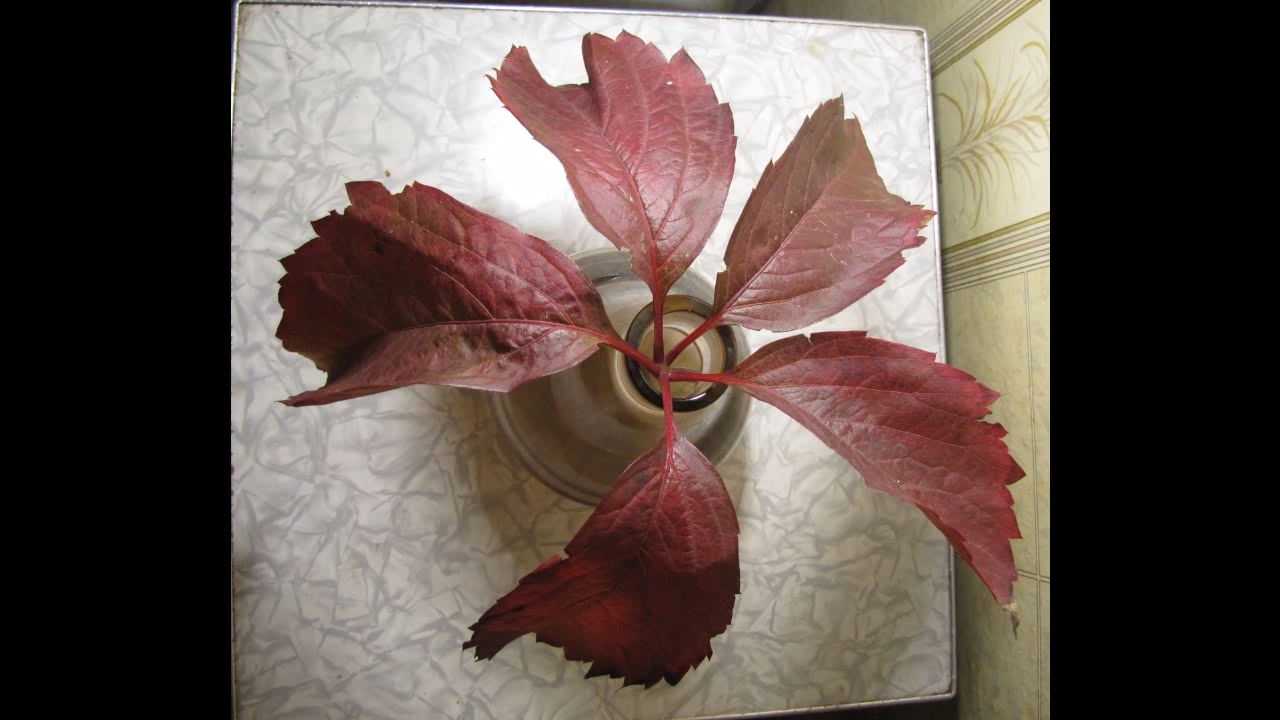
Red leaves of Parthenocissus quinquefolia and ammonia |
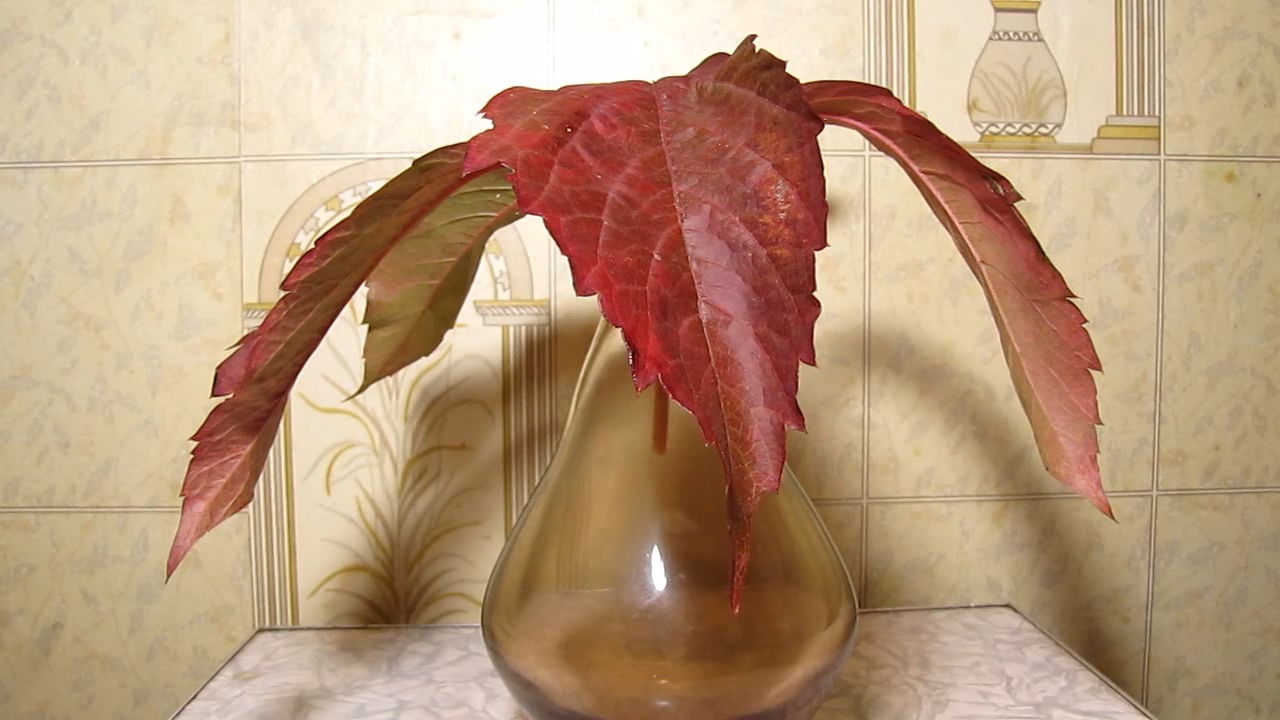
|
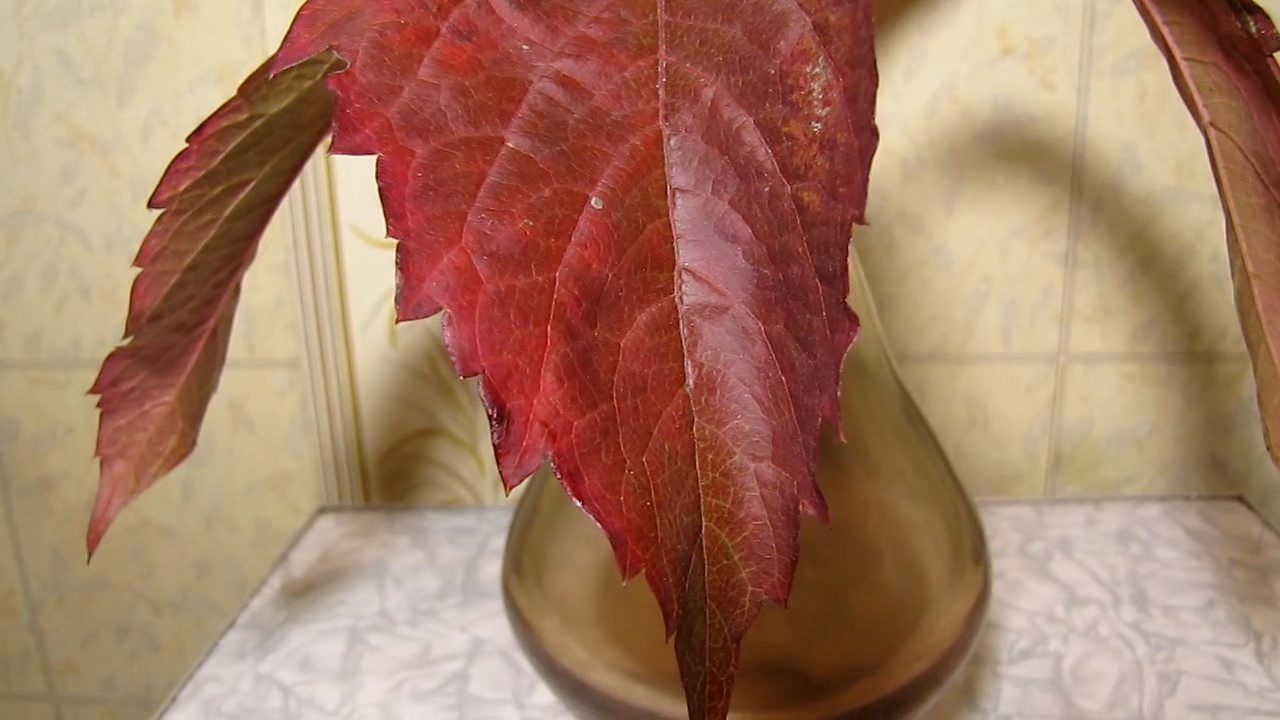
|
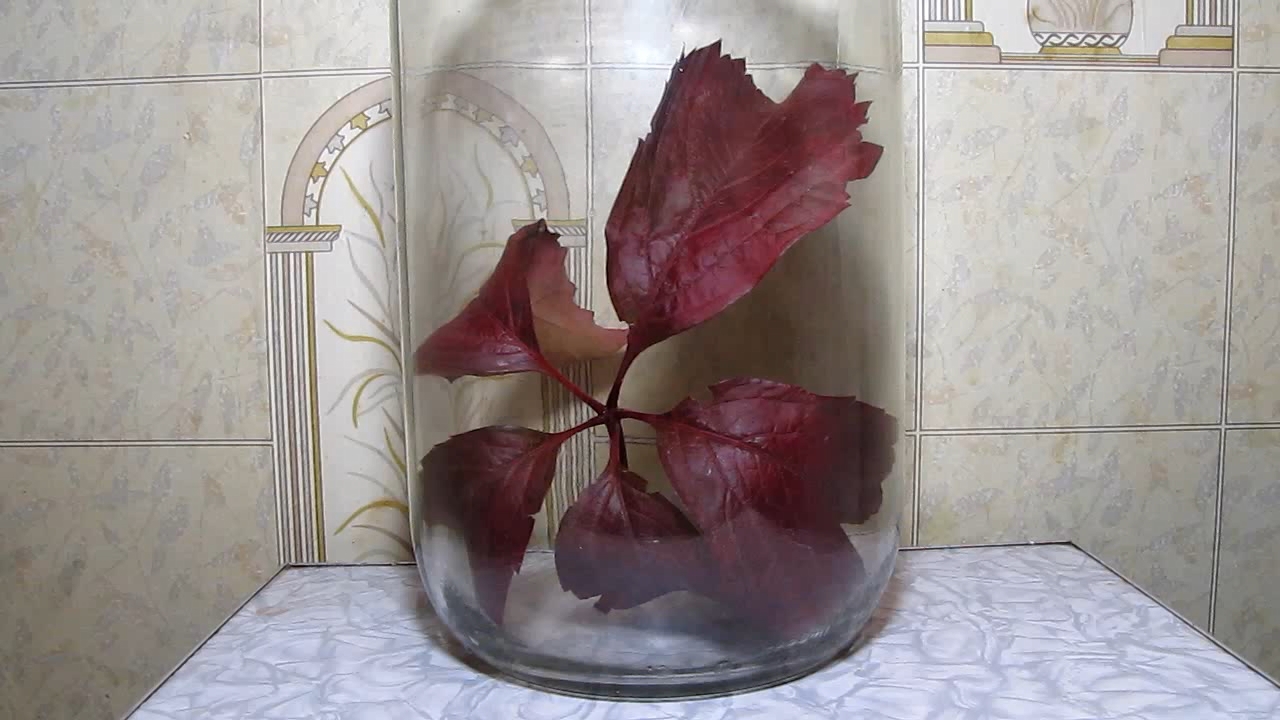
|

+NH3 |

|
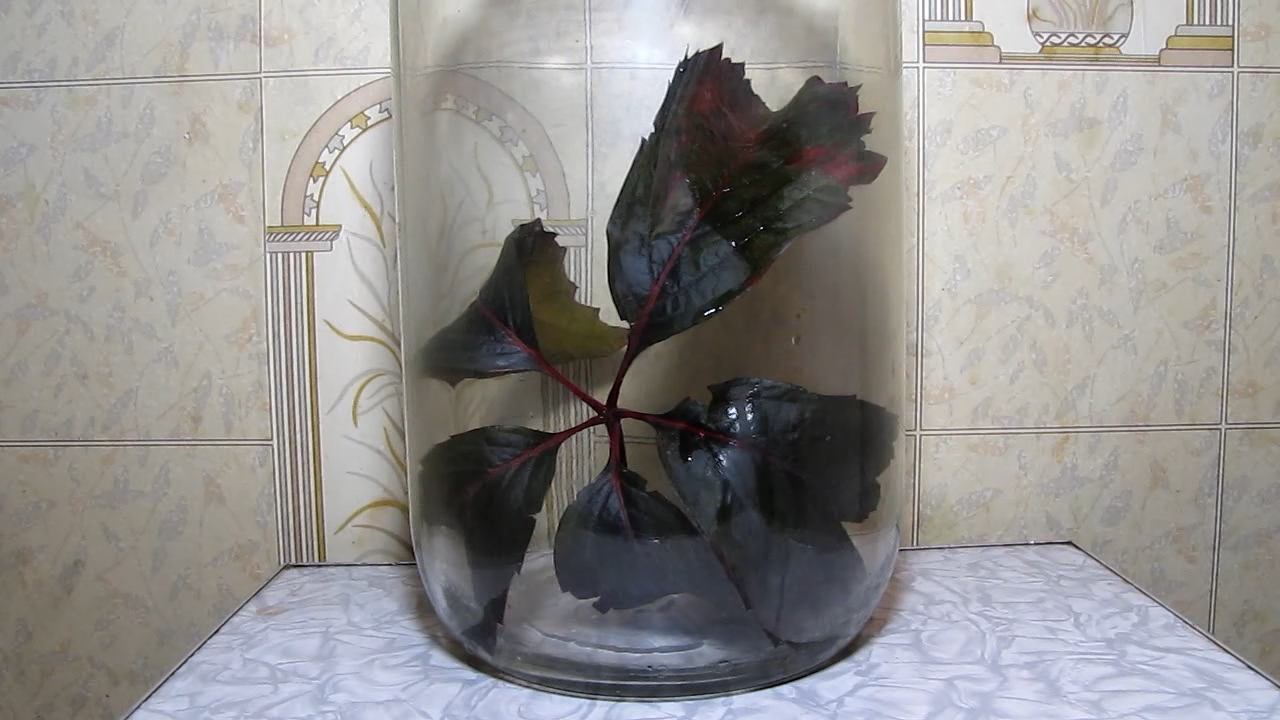
|
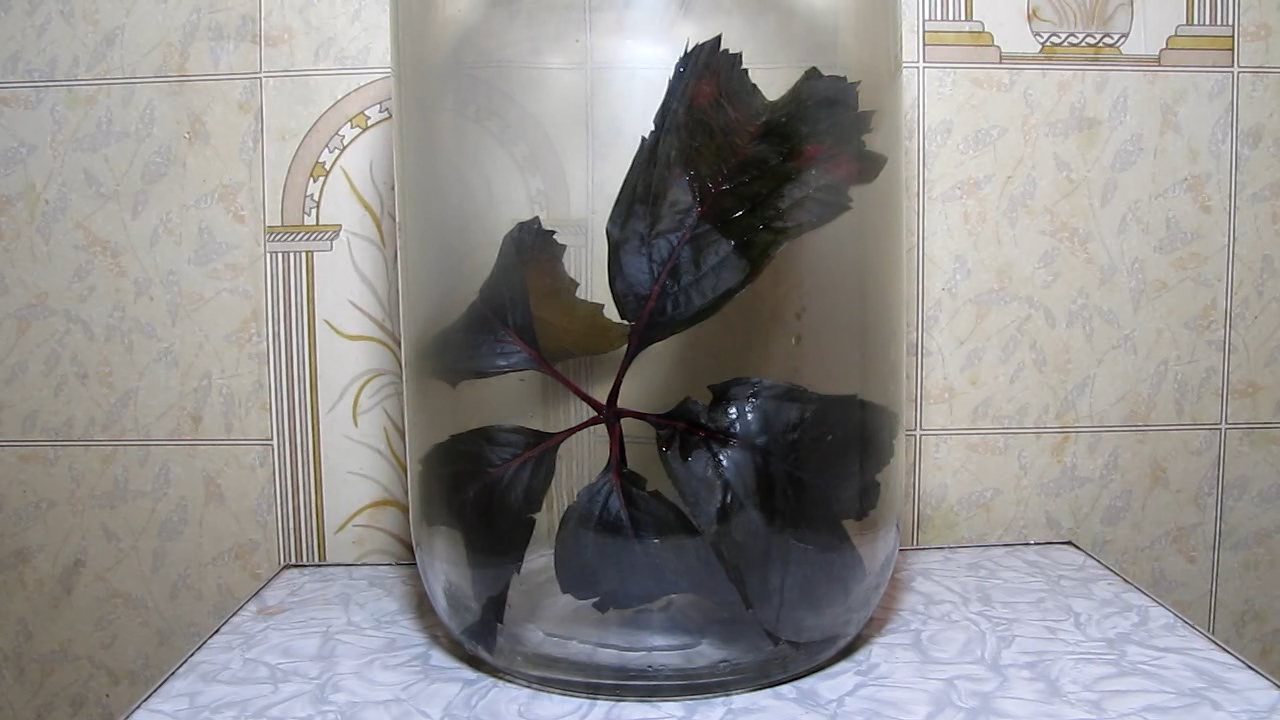
|
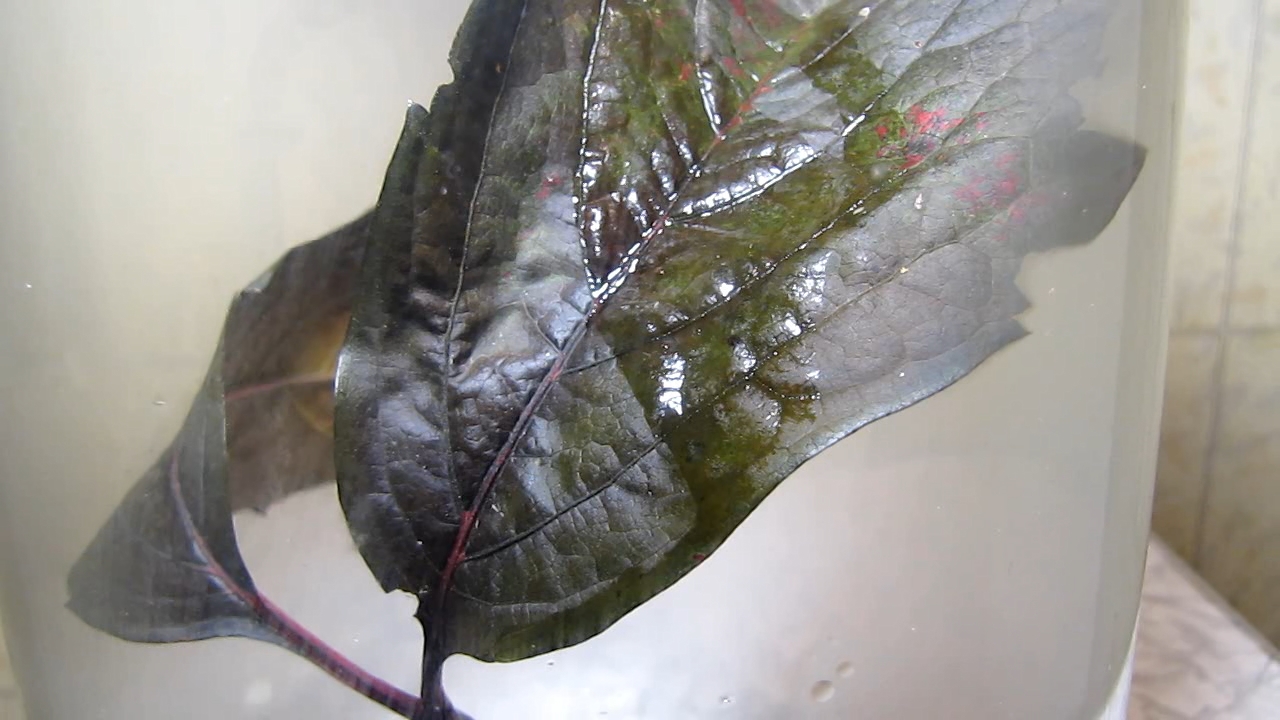
|

|
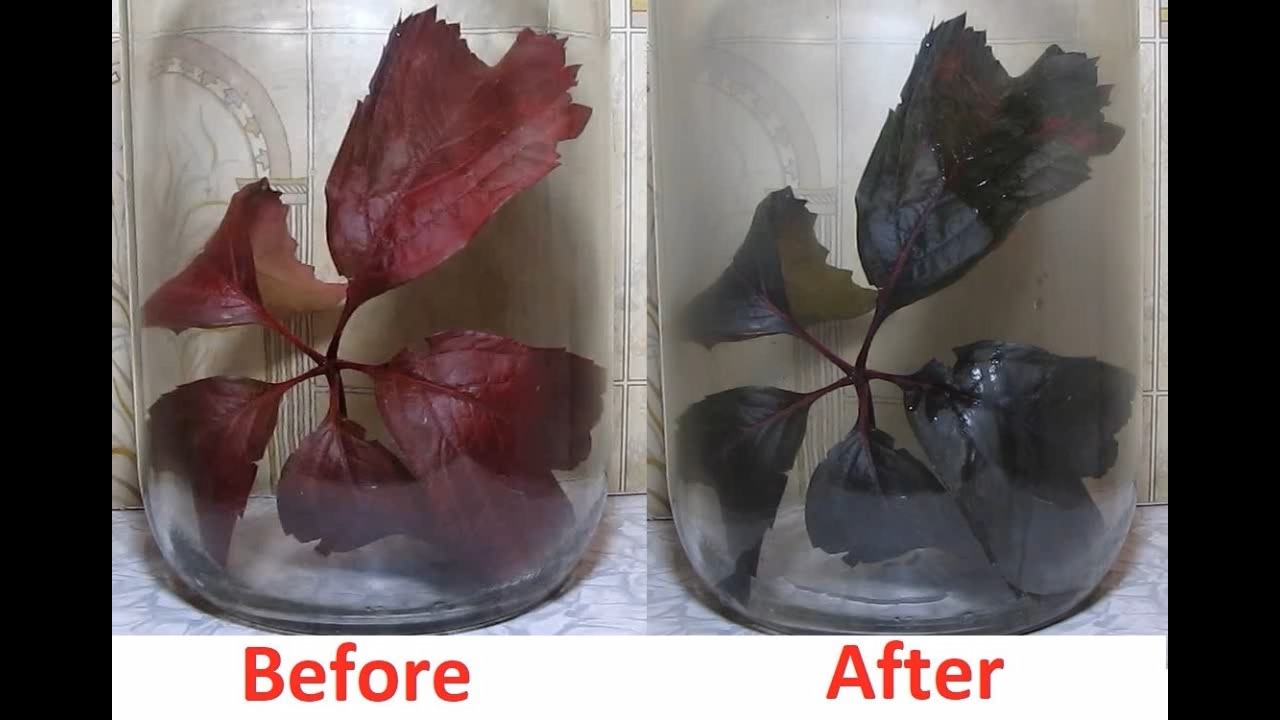
|

|

|
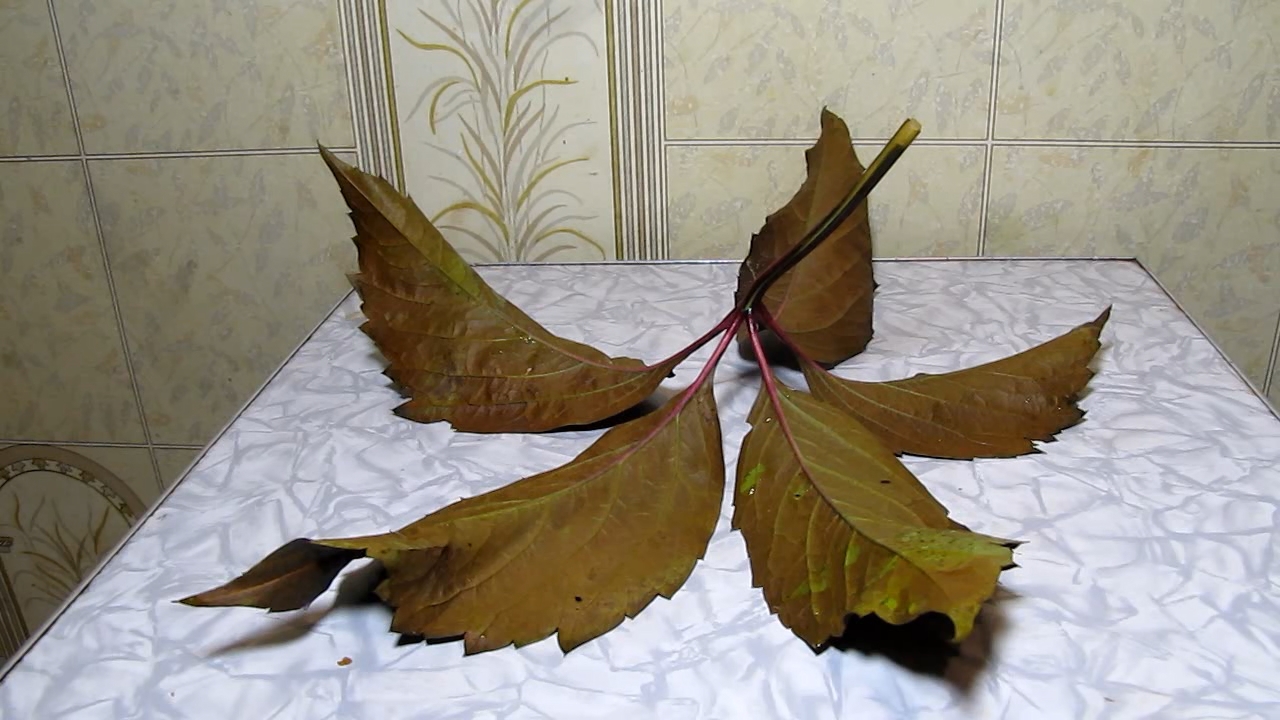
|
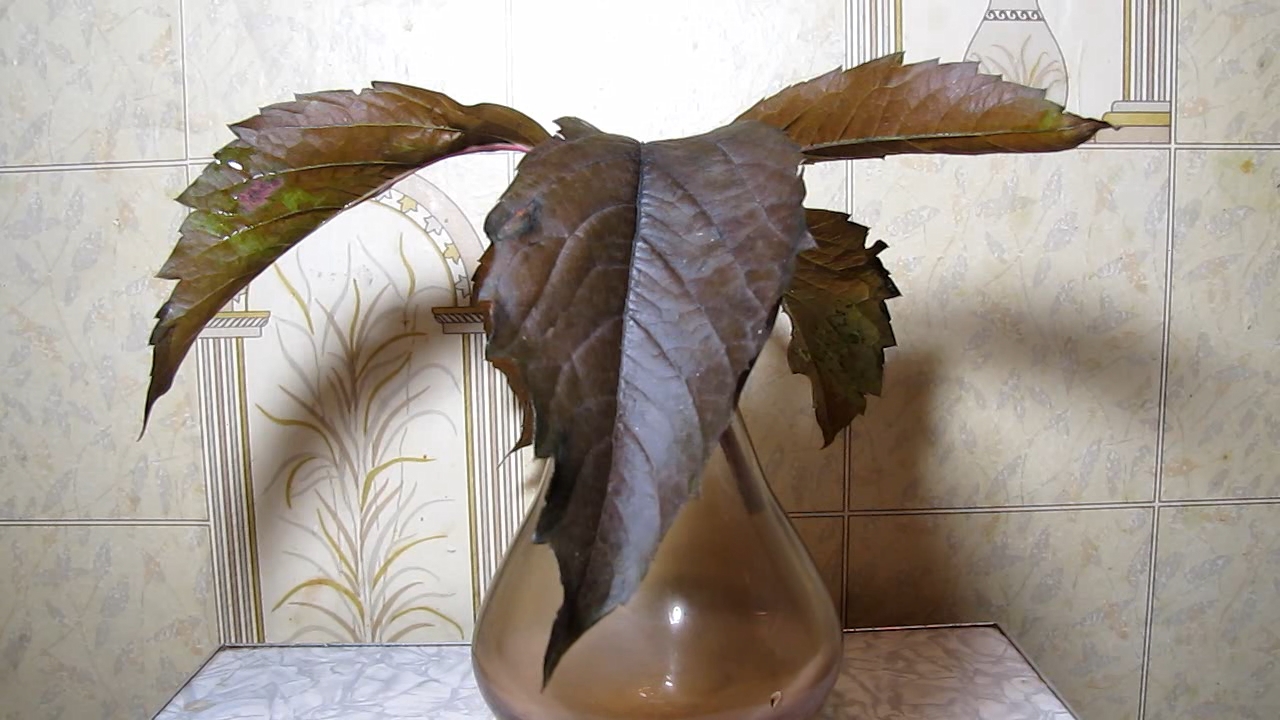
|
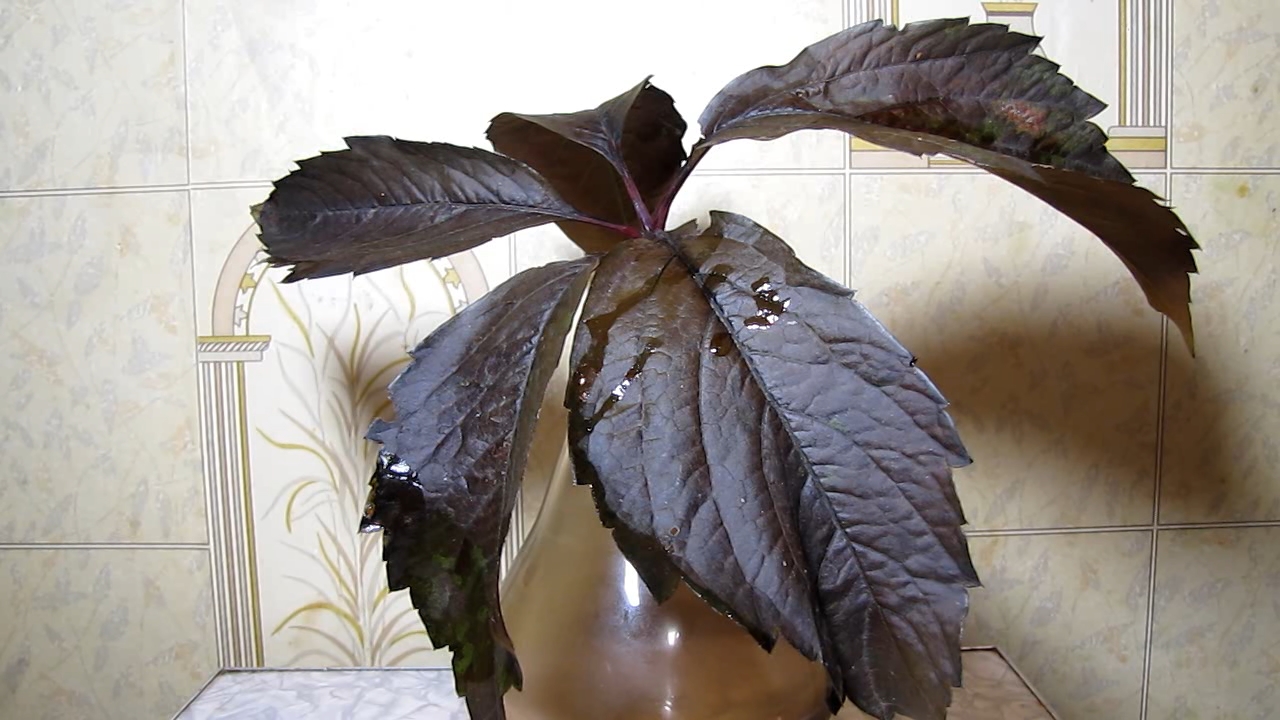
|
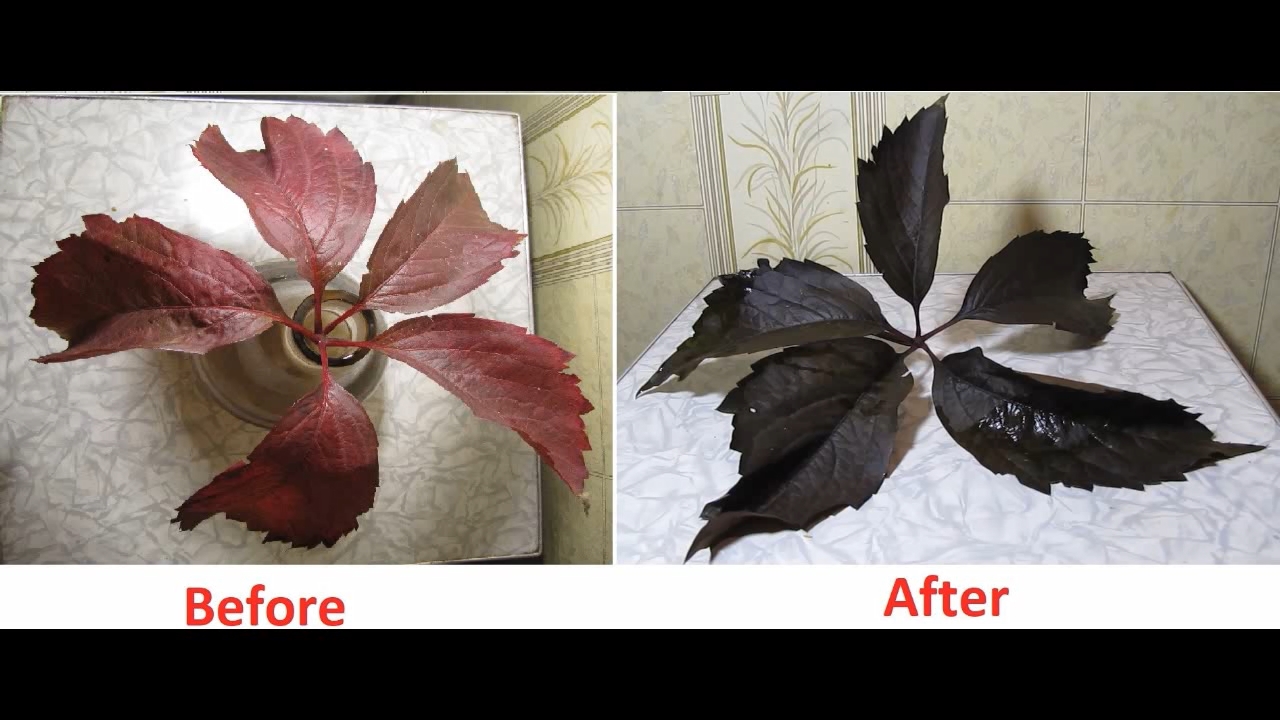
|
|
Red leaves of Parthenocissus quinquefolia, acetic acid and ammonia - pt.24
After experiments on the effect of alkali (concentrated ammonia solution) on the red leaves of Parthenocissus quinquefolia ("Virginia creeper"), it would be logical to conduct similar experiments on the effect of acids on autumn leaves. I wonder how their red/burgundy colouring will change? Time was running out - the autumn crossed the equator, and soon, the leaves would fall or dry up. Usually, a leaf fall in our country occurs in the second half of October (it's funny that the third month of autumn in Ukrainian is called "the leaf fall", although by this time, the leaves have already fallen).
Logic is one thing, but our actions are another. Instead of experimenting with acids, I continued experiments with bases. I tried to treat with ammonia other plants' red and burgundy leaves. The results were interesting. Now these experiments have been completed, I will describe them over time. As for the experiments with acids, I was delaying the time. Psychologically, treating a red plant pigment with acids does not seem promising. I intuitively assumed that a colour change would not occur (or would occur, but it would be non-contrasting). While waiting for the bus at the bus stop, I picked some red leaves of Virginia creeper (as it turned out, all the leaves fell off this vine just two days later). Finally, I decided to carry out the planned experiment. I chose to use not hydrochloric or nitric acid but weaker acetic acid (hoping it would be less destructive to plant tissue). I started the experiment at home and placed a bright red leaf of Virginia creeper in a glass. Then, I added glacial acetic acid (so the acid wetted the leaf's surface thoroughly), covered the glass with a Petri dish and waited. Forty minutes passed, but there was no change in colour. The leaf remained bright red. A new idea arose: to check whether the colour change of the pigment is reversible. First, I should take a new red leaf of Virginia creeper and treat it with ammonia; as a result, the red leaf will turn dark green. After this, I should treat the green leaf with glacial acetic acid. Would its original bright red colour return? I placed the red leaf in a glass and added a concentrated ammonia solution (to wet the surface of the leaf thoroughly). I covered the glass with a Petri dish. The surface of the leaf began to darken unevenly. Gradually, the red leaf turned dark green. The colour-changing process took several minutes. The leaf veins changed the colour the last. I took the leaf out of the glass with ammonia and photographed it next to the same Virginia creeper leaf, but not treated with ammonia. I placed a green leaf (treated with ammonia) in the glass. I added glacial acetic acid (also trying to wet the leaf's surface with the liquid). The green leaf first turned red-brown, then it turned brown. Thus, the original red colour of the leaf did not return (the treatment with glacial acetic acid did not cause the green leaf to turn red). Apparently, during the experiment, the red pigment was destroyed. __________________________________________________ 3 After the experimental work was completed, I found that the experiments called “Acid Rain Experiments”, “Acid Rain Effects”, etc., are popular on the English-language Internet. They are conducted so that students can model (and observe) the effects of acid rain on various living and nonliving objects. Vinegar often plays the role of “acid rain”. This is not exactly what we are doing in this article, but there are similarities. |
|
Красные листья Parthenocissus quinquefolia, уксусная кислота и аммиак - ч.24
После экспериментов по действию щелочи (концентрированный раствор аммиака) на красные листья Parthenocissus quinquefolia ("дикий виноград") было бы логично провести аналогичные опыты по действию кислот на осенние листья [3]. Интересно, как изменится их красная/бордовая окраска? Время поджимало, осень перешла экватор: скоро листья опадут или засохнут. Обычно листопад у нас происходит во второй половине октября (забавно, что третий месяц осени в украинском языке буквально называется "листопад", хотя к этому времени листья уже успевают опасть). Логика - это одно, а наши действия - другое. Вместо экспериментов с кислотами сначала я продолжил эксперименты с основаниями - попробовал действовать аммиаком на красные и бордовые листья других растений. Получились интересные результаты. Сейчас эти эксперименты закончены - со временем их опишу. Насчет кислот - я все затягивал время. Психологически идея действовать кислотами на красный растительный пигмент не вызывала энтузиазма, поскольку интуитивно я предполагал, что изменения цвета не произойдет (или произойдет, но будет неконтрастное). Ожидая автобуса на остановке, сорвал несколько красных листьев дикого винограда (как оказалось, всего за два дня до того, как все листья с этой лианы опали). Наконец, решился провести запланированный эксперимент. Решил использовать не соляную или азотную кислоту, а более слабую уксусную (в надежде, что она будет в меньшей мере разрушать растительные ткани). Дома поместил ярко-красный лист дикого винограда в стакан. Добавил ледяную уксусную кислоту (так, чтобы кислота хорошо смочила поверхность листа), накрыл стакан чашкой Петри и стал ждать. Прошло 40 минут, но изменений цвета не произошло. Лист так и остался ярко-красным. Возникла новая идея: проверить, обратимо ли изменение окраски пигмента. Взять новый красный лист дикого винограда. Сначала подействовать на него аммиаком - красный лист станет темно-зеленым. После этого подействовать на позеленевший лист ледяной уксусной кислотой. Вернется ли его начальная ярко-красная окраска? Поместил красный лист в стакан, добавил концентрированный раствор аммиака (чтобы хорошо смочить поверхность листа). Накрыл стакан чашкой Петри. Поверхность листа стала неравномерно темнеть. Постепенно красный лист стал темно-зеленым. Процесс изменения цвета занял несколько минут. Последними меняли цвет жилки листа. Извлек лист из стакана с аммиаком, сфотографировал его рядом с таким же листом дикого винограда, но не обработанным аммиаком. Помыл стакан от аммиака и поместил в него зеленый лист (который был обработан аммиаком). Добавил ледяную уксусную кислоту (также стараясь смочить жидкостью поверхность листа). Зеленый лист стал сначала красно-коричневым, затем он приобрел коричневый цвет. Таким образом, первоначальная красная окраска листа не вернулась (действие ледяной уксусной кислоты не привело к тому, что зеленый лист снова стал красным). По-видимому, в процессе эксперимента произошло разрушение красного пигмента. __________________________________________________ 3 После завершения экспериментальной работы я обнаружил, что в англоязычном Интернете популярны эксперименты под названием "Acid Rain Experiments", "Acid Rain Effects" и т.п. Они проводятся для того, чтобы учащиеся могли моделировать (и наблюдать) воздействие кислотных дождей на различные живые и неживые объекты. Уксус часто играет роль «кислотного дождя». Это не совсем то, что мы делаем в этой статье, но сходство есть. |
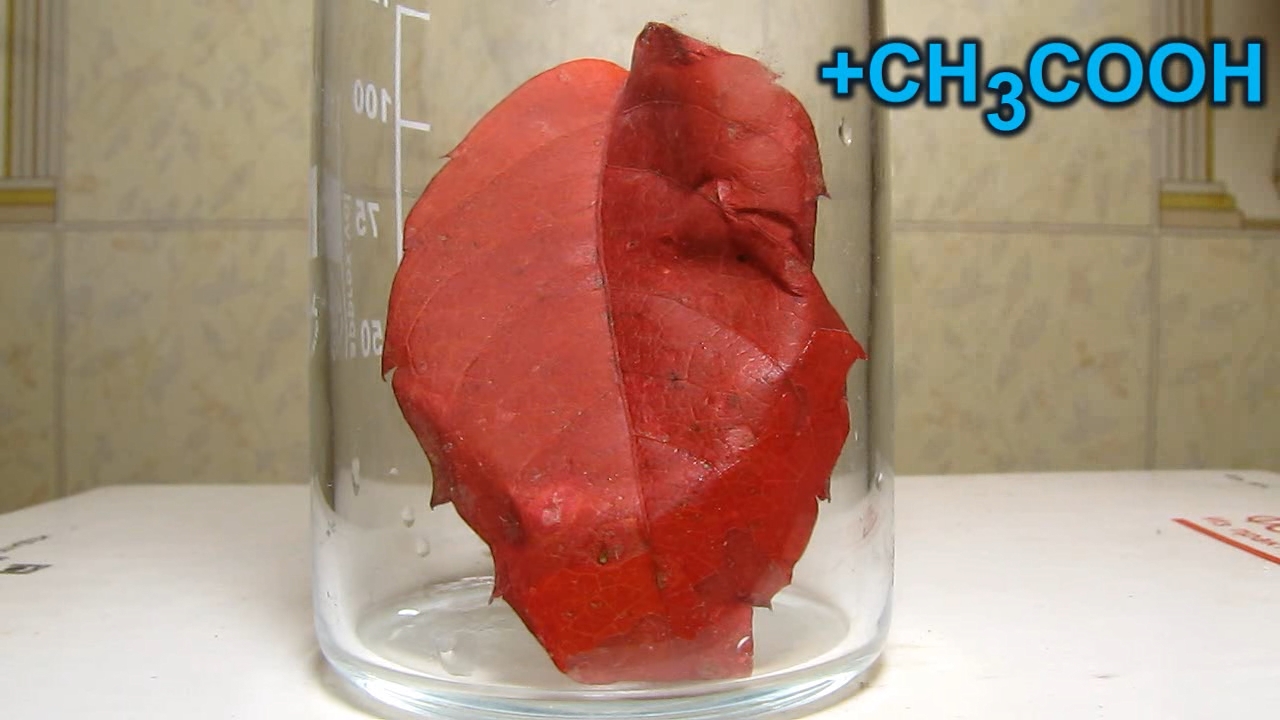
Red leaves of Parthenocissus quinquefolia and acetic acid |
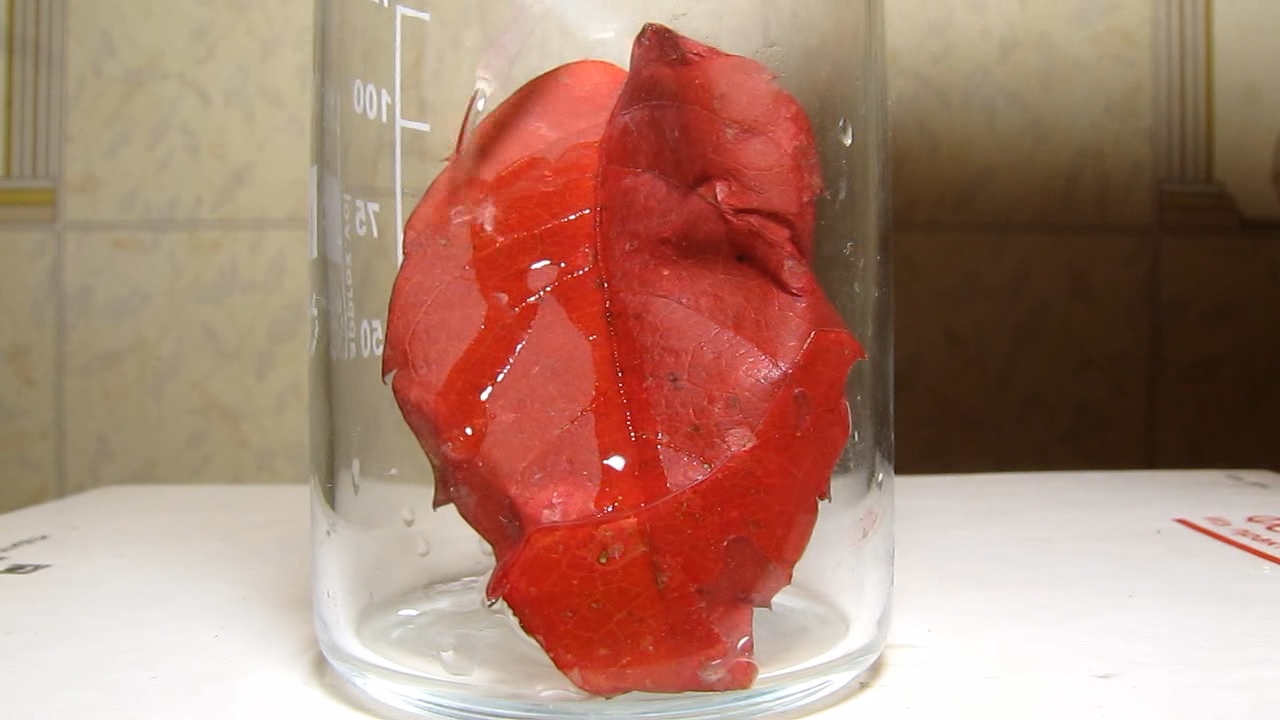
|
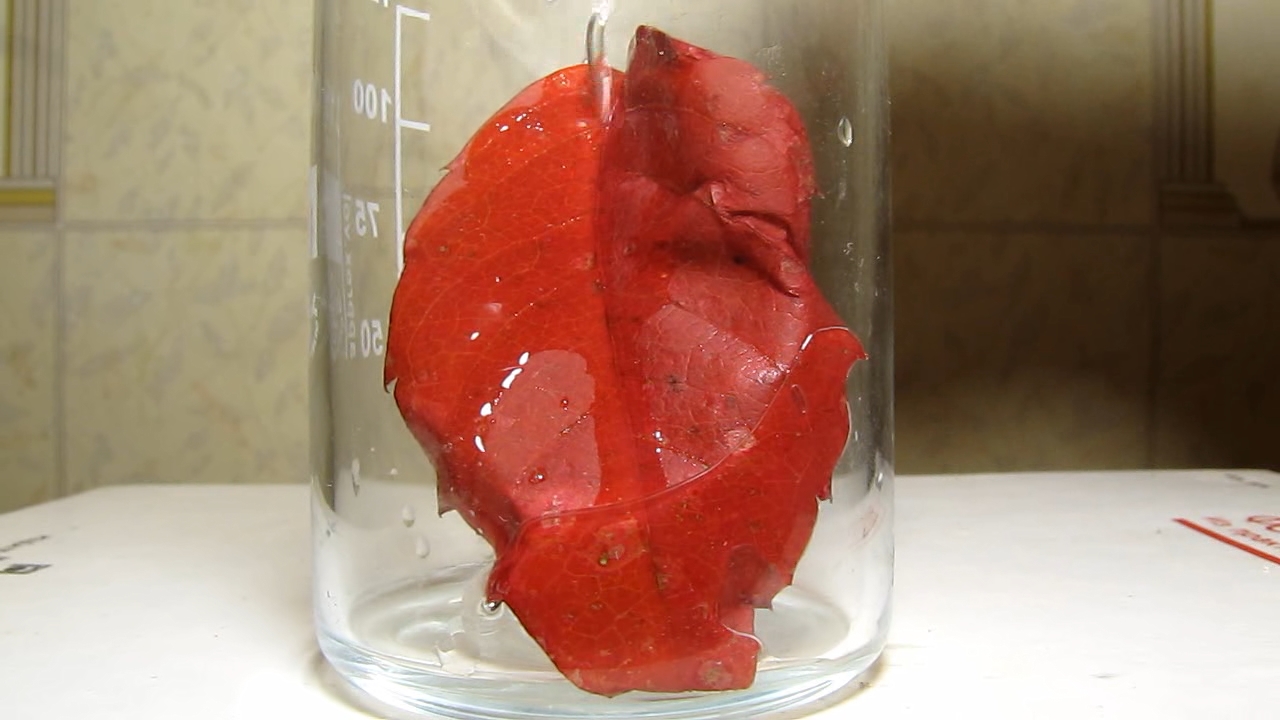
|
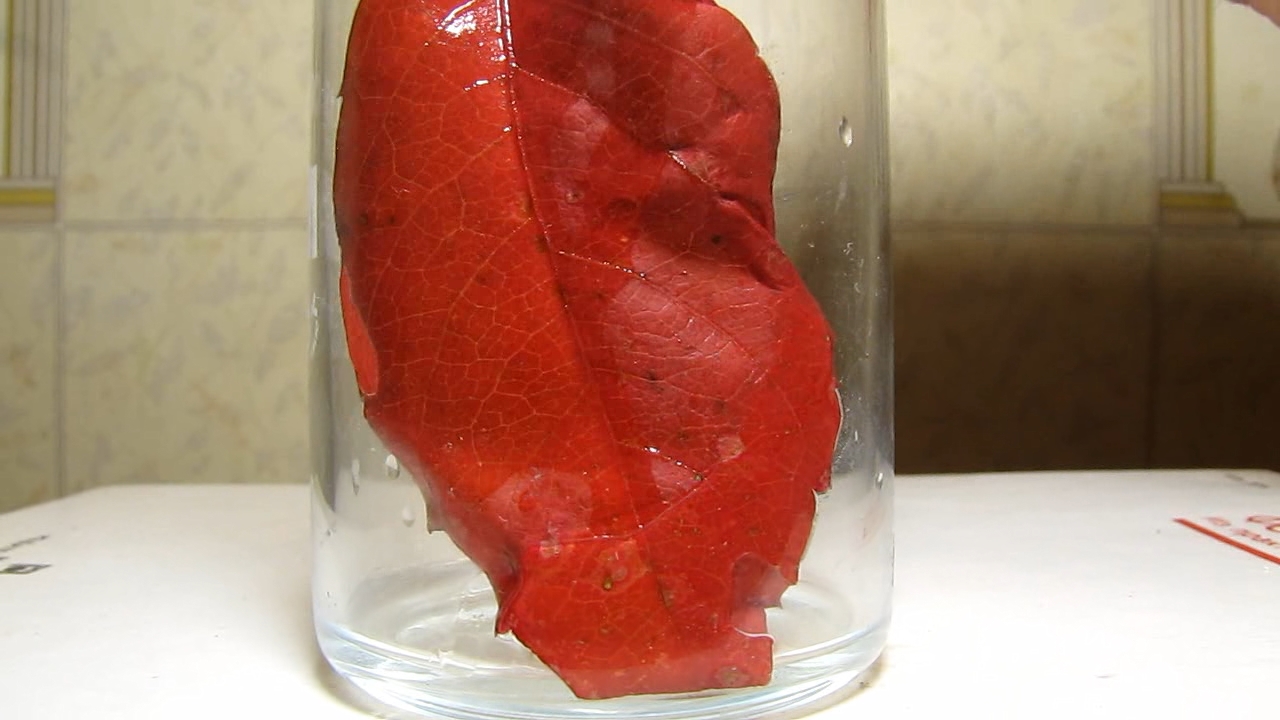
|

|

|
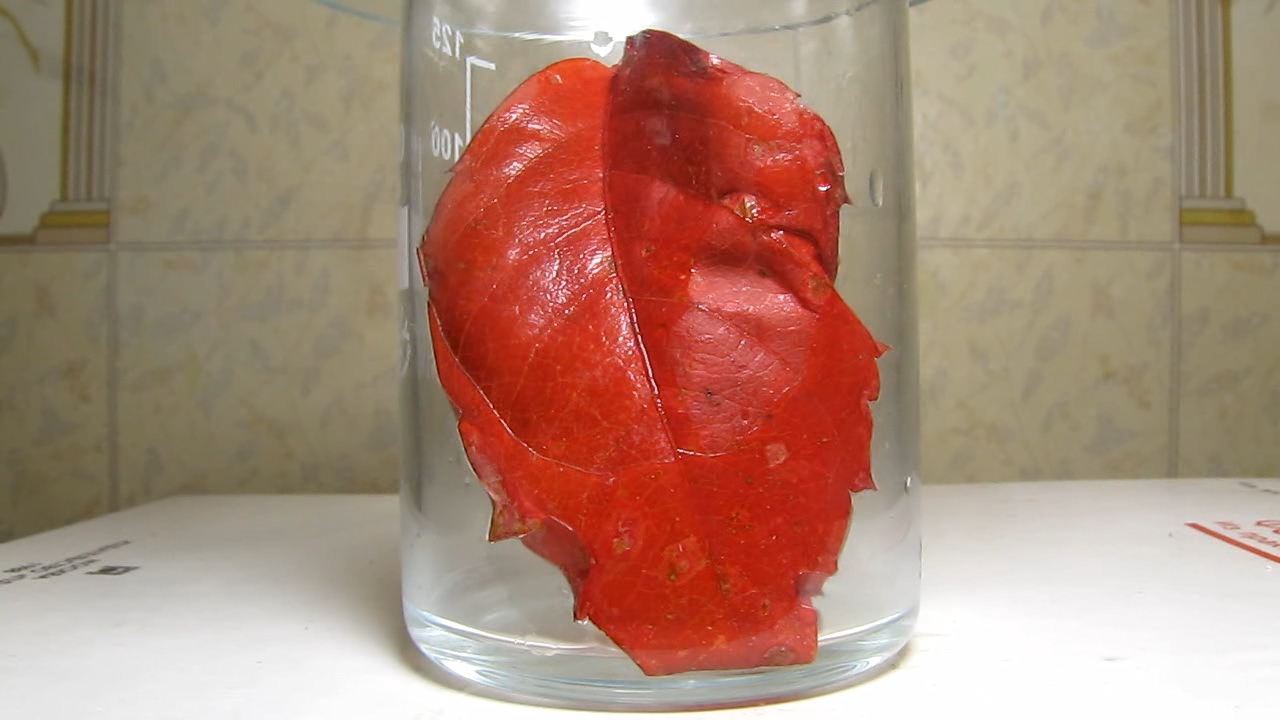
There are no changes after 40 minutes |
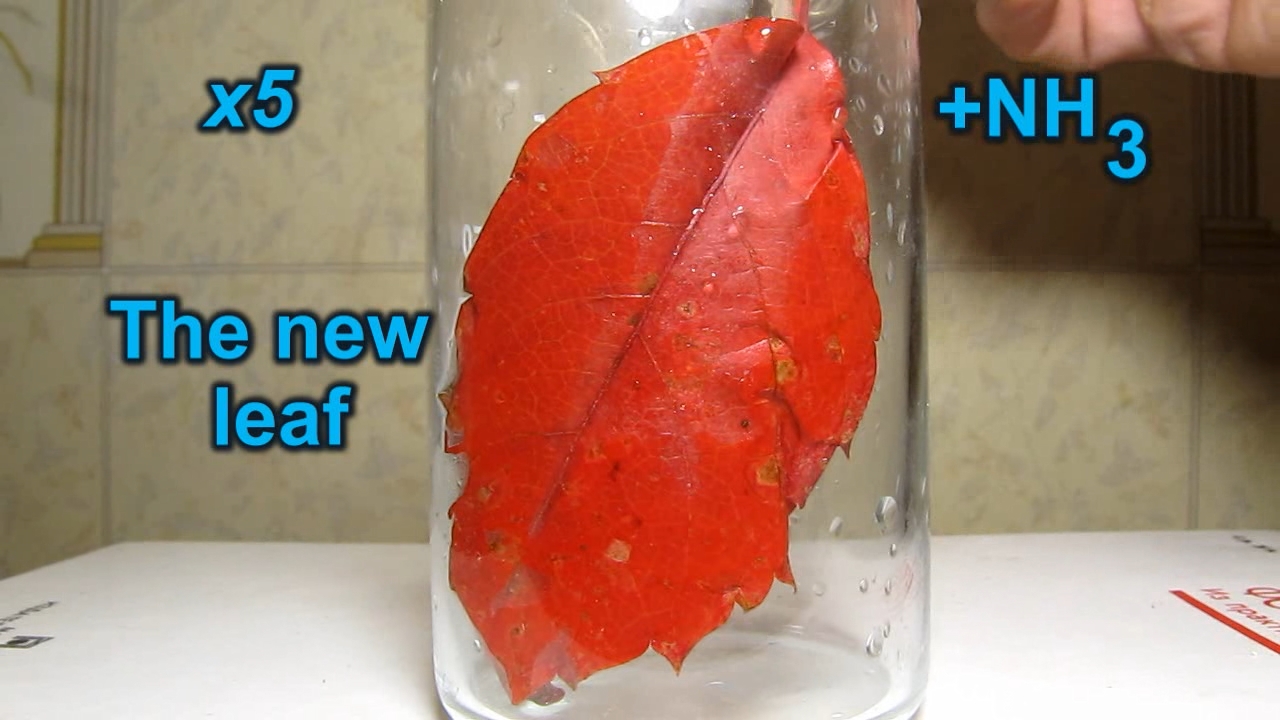
Red leaves of Parthenocissus quinquefolia and ammonia |
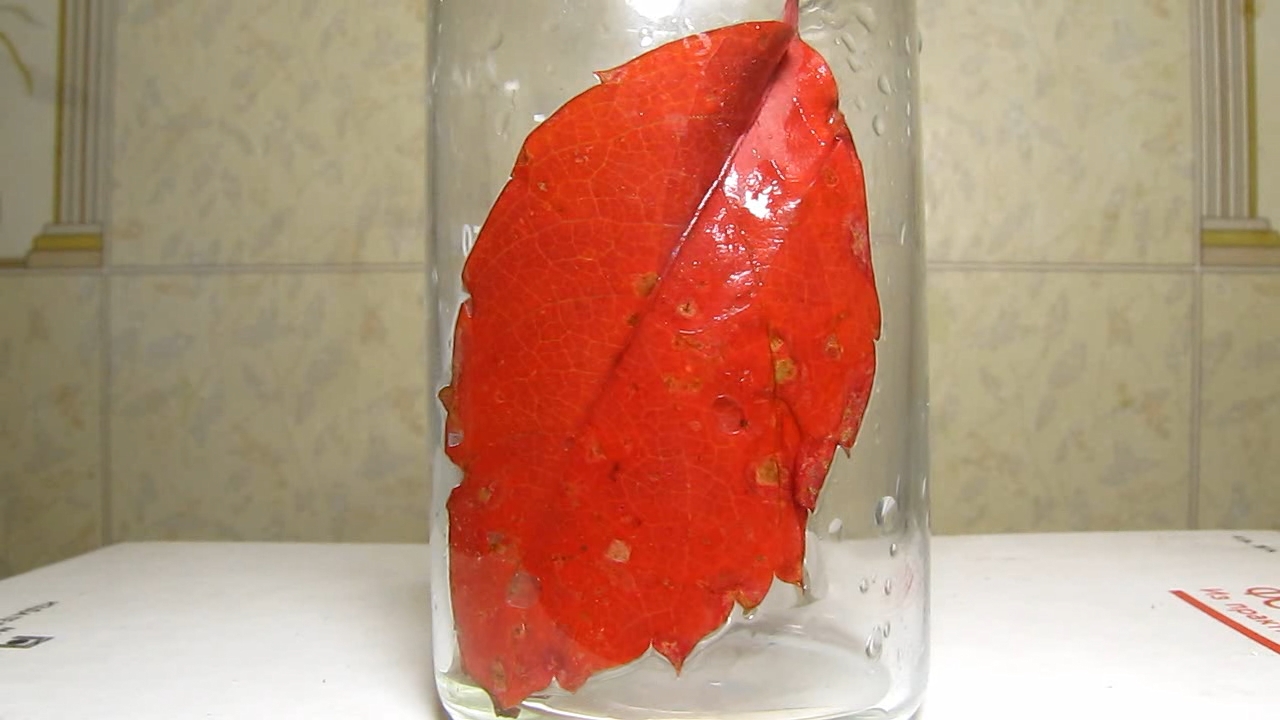
|
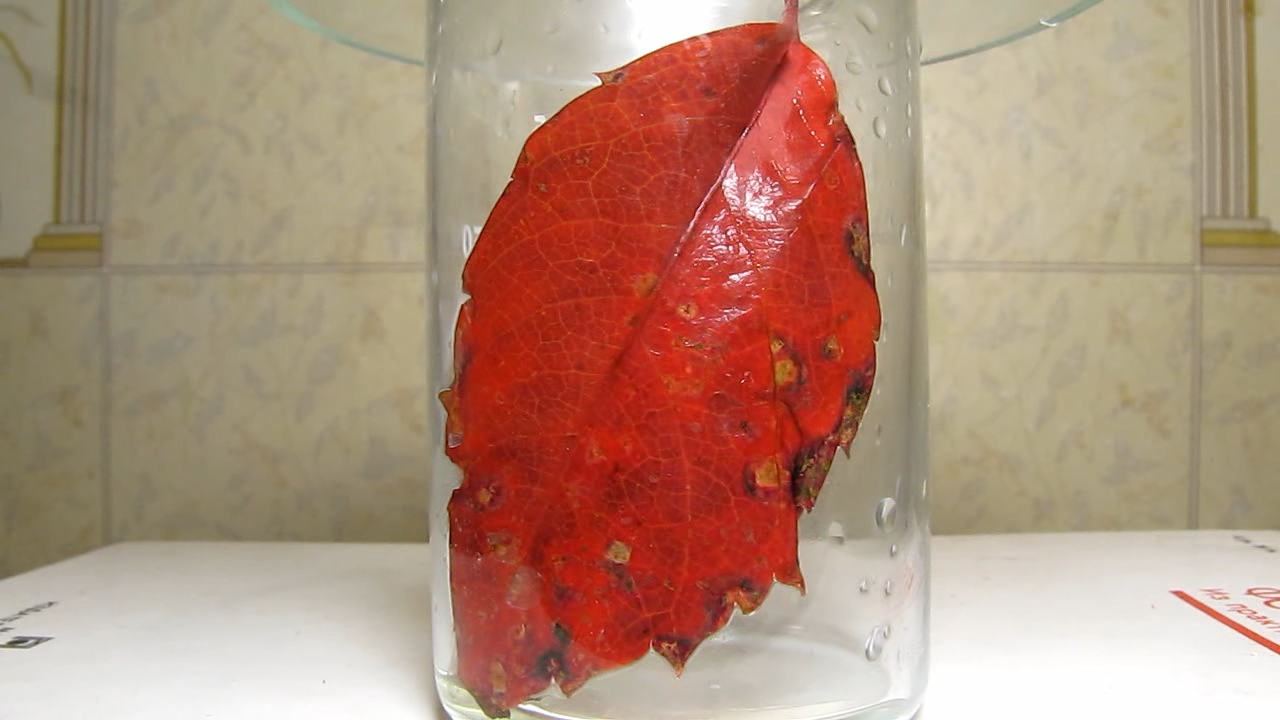
|

|

|
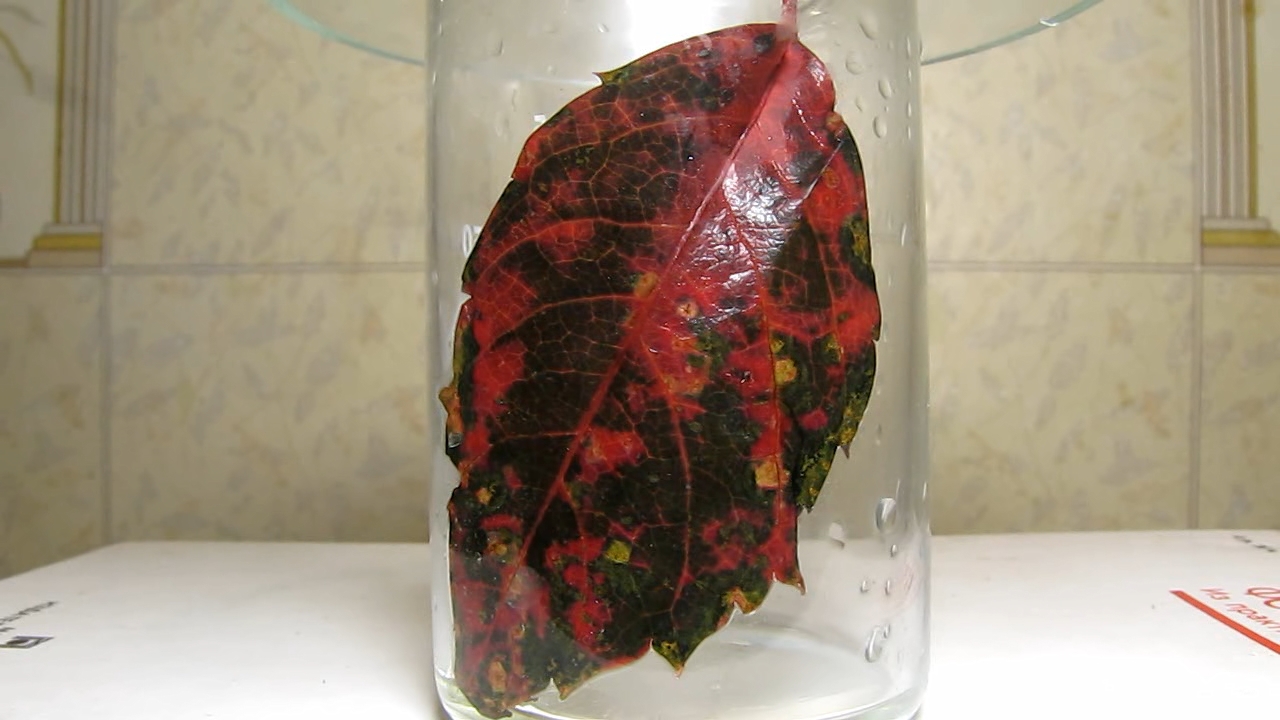
|
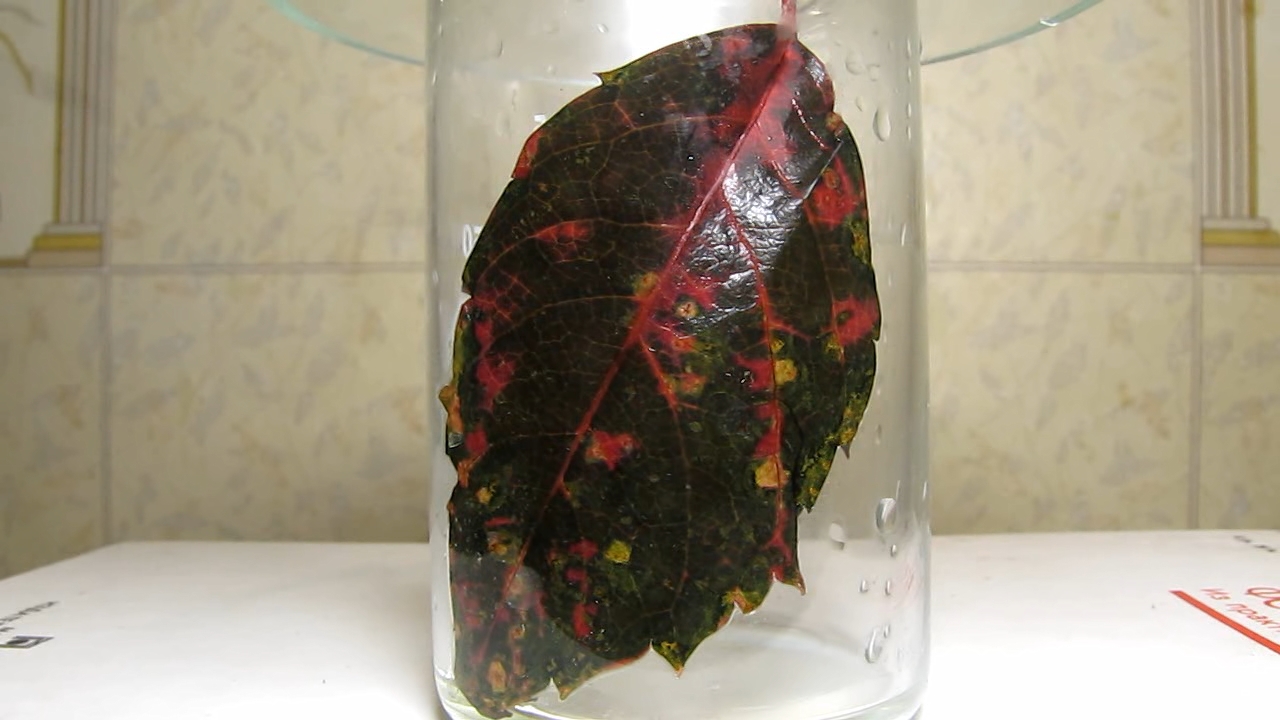
|
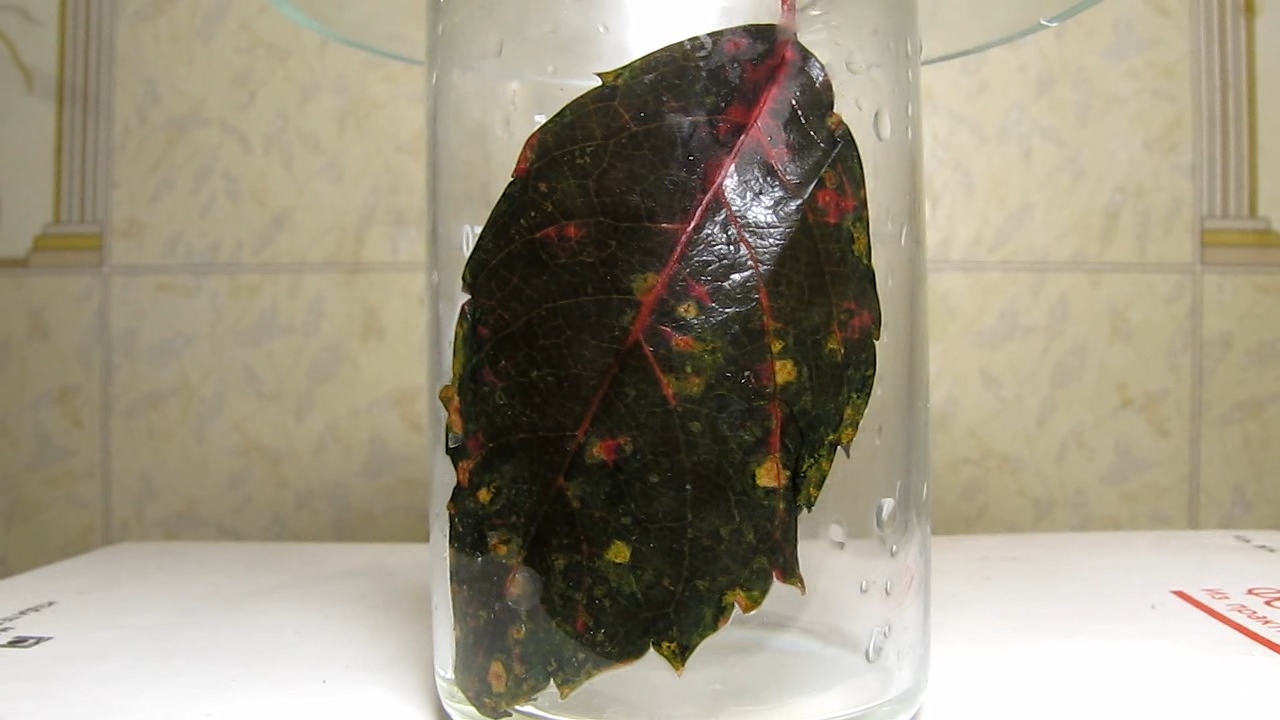
|
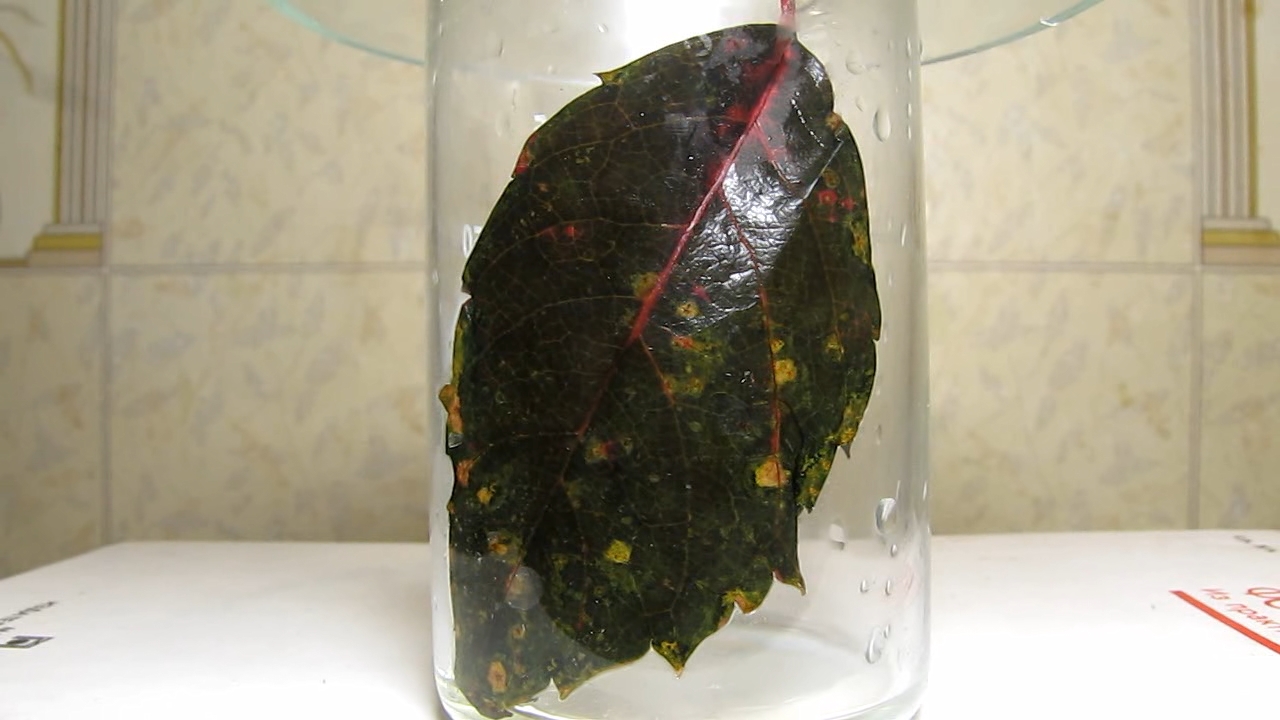
|

|

|
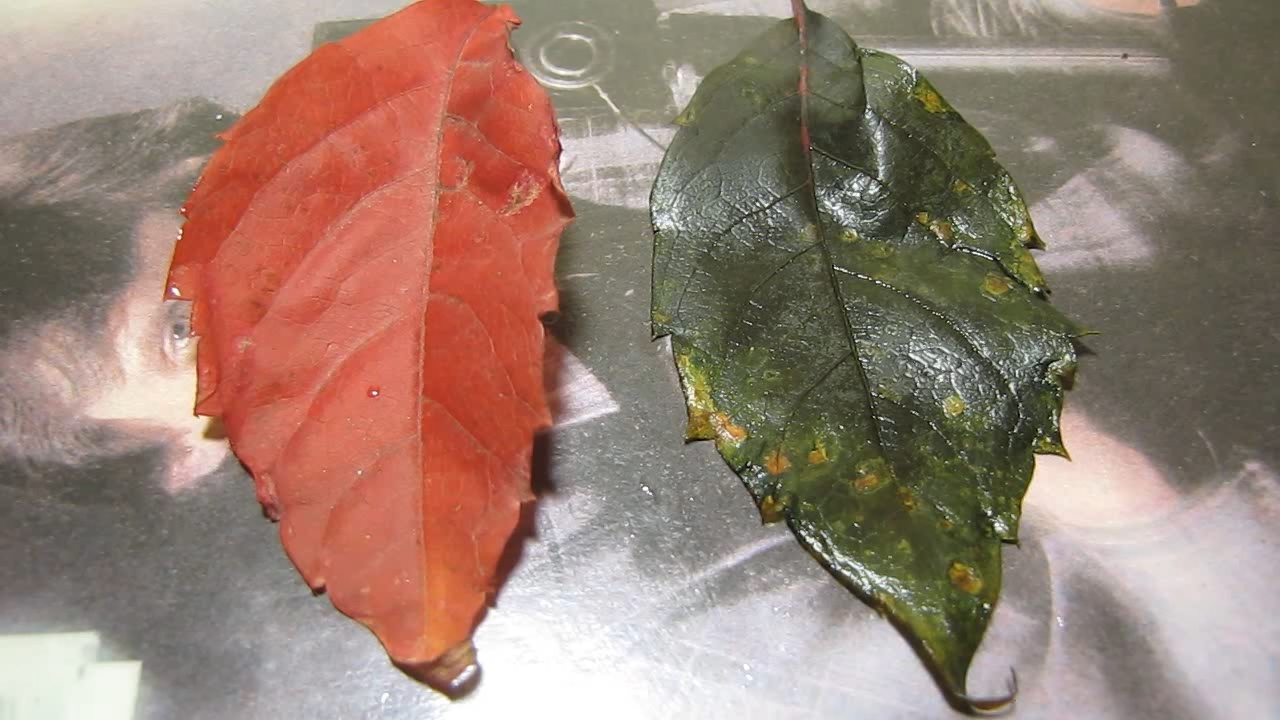
|
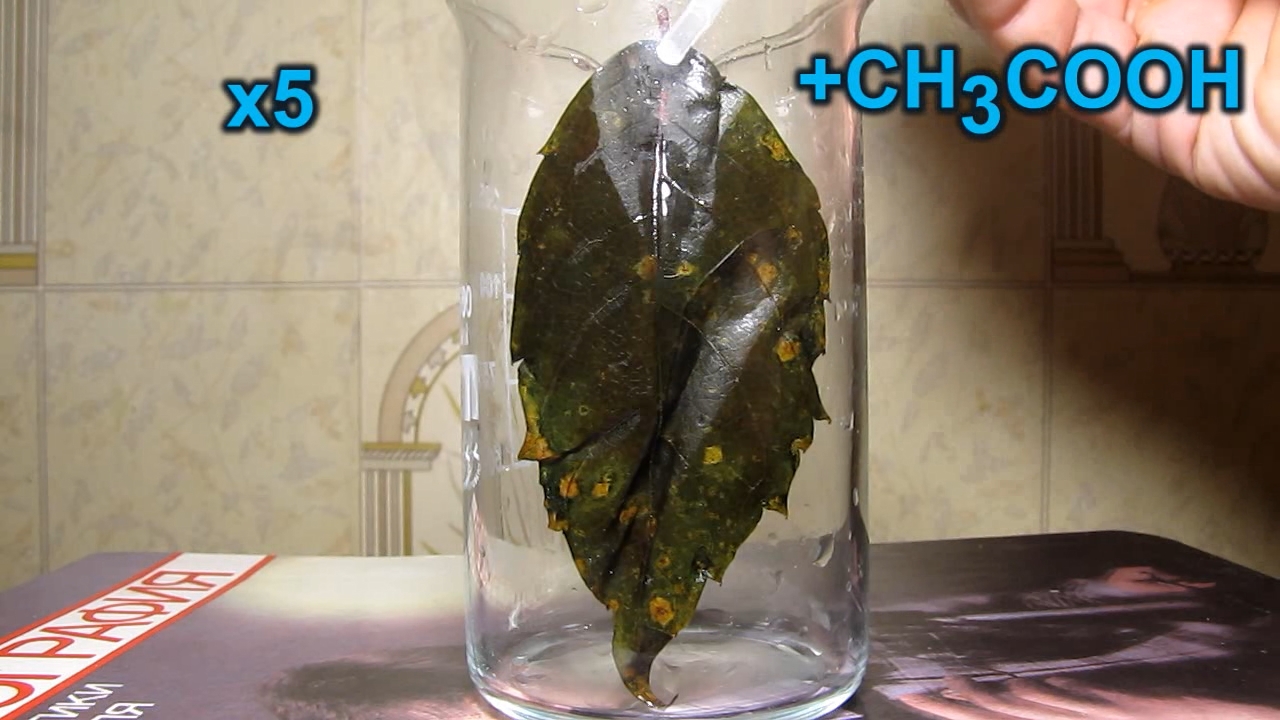
The treatment with acetic acid after the treatment with ammonia. |

|
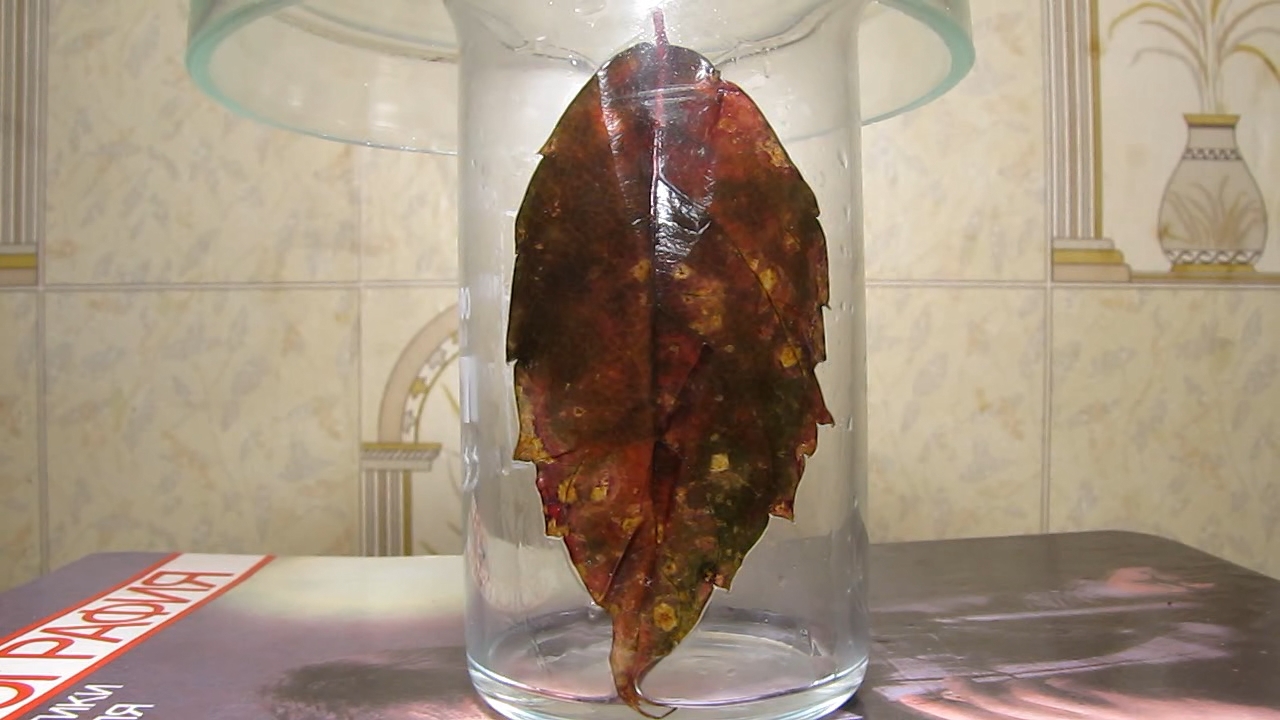
|

|
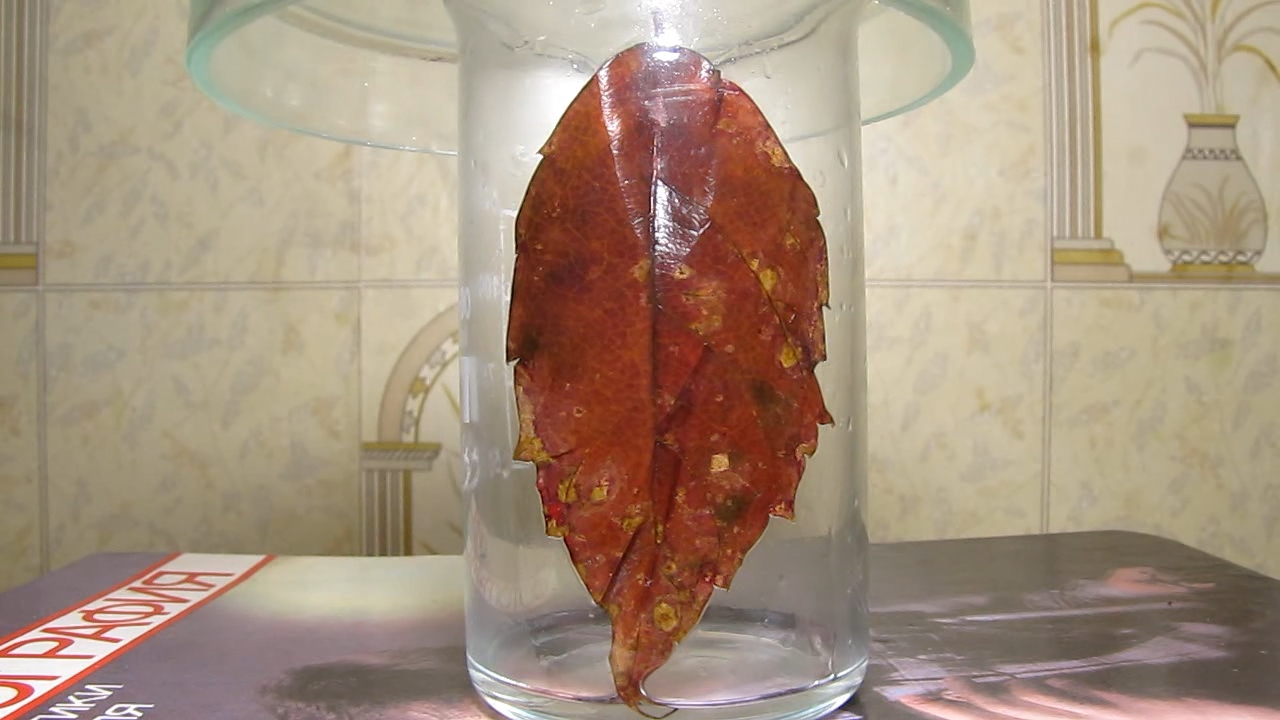
|

|

|
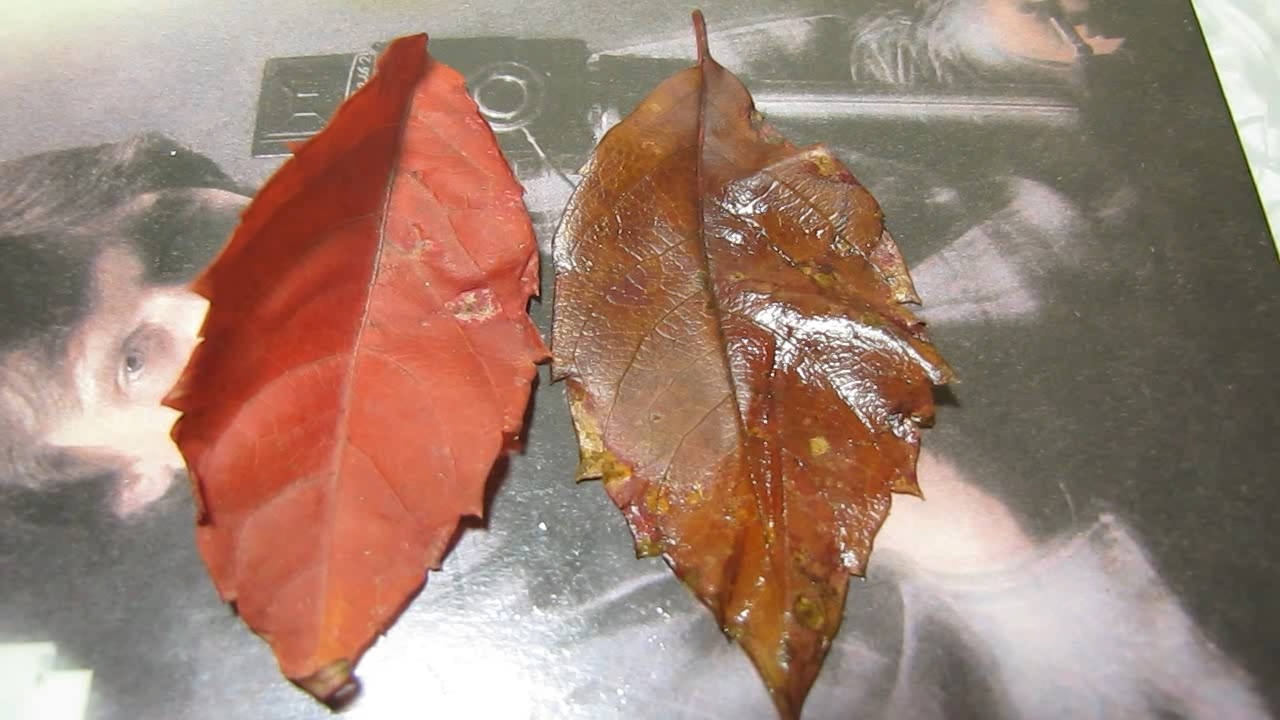
|